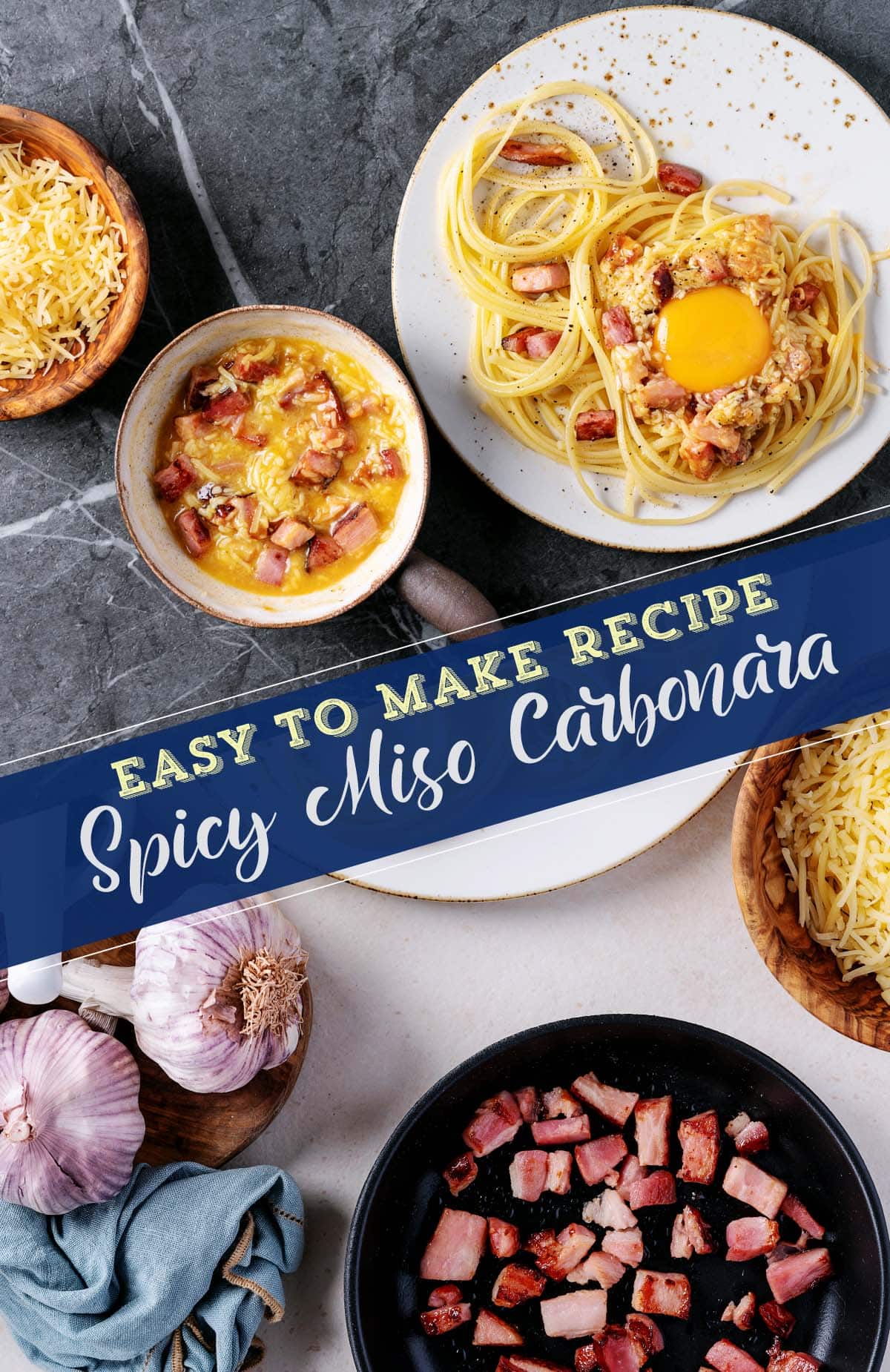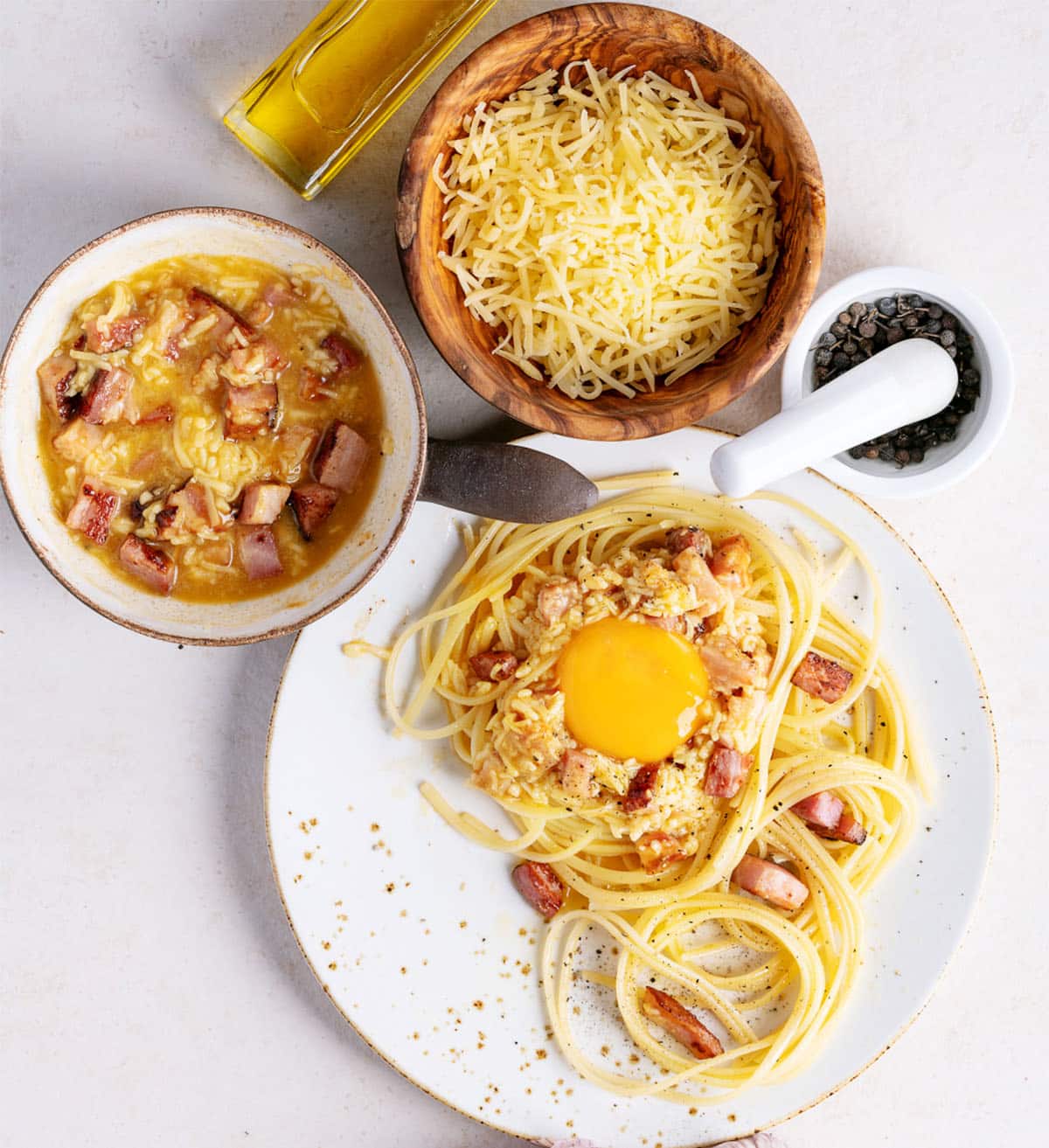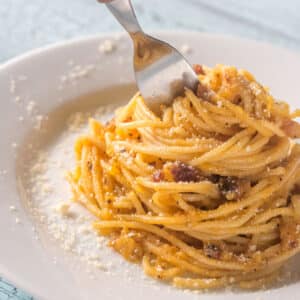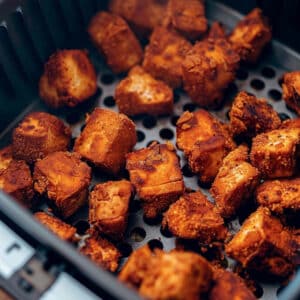Spicy miso carbonara is a delicious and unique twist on the classic Italian dish. This recipe combines Carbonara's creamy, rich flavors with miso paste's bold and spicy flavors. The result is a dish that is sure to impress your taste buds.
Are you ready to take your carbonara game to the next level? But before you start cooking, remember a few key things to ensure that your spicy miso carbonara turns out perfectly. From selecting the right ingredients to mastering the cooking technique, pay attention to these tips and tricks to make the perfect Spicy Miso Carbonara. Keep reading to discover the secret behind the perfect spicy miso carbonara recipe.
Take Aways
- Work quickly and efficiently when adding the pasta to the sauce to prevent the eggs from scrambling and ensure a smooth texture.
- Use pasta water to adjust the consistency of the sauce if it is too thick.
- Be mindful of the heat level and remove the pan from the heat immediately once the sauce evenly coats the pasta and the eggs are cooked to your liking.
Carbonara: An overview

Carbonara is a traditional Italian pasta dish believed to have originated in Rome. It is made with pasta, typically spaghetti, and a sauce made from eggs, cheese, bacon, or Pancetta. Moreover, the sauce is cooked in a pan until it thickens and is then tossed with the cooked pasta. Additionally, it is often garnished with black pepper and parsley.
The dish gained popularity in the United States after World War II when American soldiers stationed in Italy were introduced to it. It has since become a staple in Italian-American cuisine. The dish is known for its rich, creamy sauce and simplicity, with just a few key ingredients.
Read:
Adding a Kick of Flavor: The Spicy Miso Twist
The spicy miso twist in this carbonara recipe introduces a unique and flavorful twist to the traditional dish. Miso, a fermented soybean paste, is a staple in Japanese cuisine and has a savory and slightly salty flavor. In this recipe, we use spicy miso, which is made by mixing miso with chili flakes; this adds a spicy kick to the dish.
The spicy miso is used for cooking a sauce with eggs, cheese, and bacon. The spicy miso adds a depth of flavor and a new level of complexity to the dish, making it stand out from the traditional recipe. Combined with the pasta, it creates a delicious, unique version of Carbonara that will please any palate.
Adding a kick of flavor to traditional Carbonara makes the spicy miso twist stand out. The spicy element of the miso adds a level of heat and complexity that complements the creamy, rich sauce. Adding spicy miso elevates the dish by infusing it with bold, umami-rich flavors.

Ingredients you'll need:
- 8 oz spaghetti
- 2 large eggs + 1 egg yolk
- 3 oz Parmigiano Reggiano, grated
- 4 oz pancetta, diced
- 1 teaspoon ground black pepper
- 1 tablespoon miso paste
- 1 tablespoon gochujang
- ¼ cup noodle water
- 1 tablespoon Furikake
- 2 cloves of garlic, minced
- Bonito flakes for garnish (optional)
Note:
The gochujang, furikake, and bonito flakes are added for extra flavor and garnish; you can adjust the measurements to your preference. The noodle water is added to the sauce to make it more creamy. You can add more or less to your desired consistency.
Step-by-step instructions for making the recipe
Crafting the Carbonara Sauce:
Step 1 Start by separating the eggs.
Carefully crack two whole eggs and one yolk into a mixing bowl, allowing the whites to drip into a separate bowl for another use.
Step 2 Grate the cheese.
Grate the cheese. Using a box grater or a Microplane, finely grate 3 oz of Parmigiano Reggiano and add it to the bowl. It's important to use freshly grated cheese for optimal melting and flavor.
Step 3 Add depth of flavor.
Stir in 1 tablespoon each of miso paste and gochujang in the bowl. Adjust the amount of each to taste. The miso adds a subtle umami flavor, while the gochujang adds a spicy kick.
Step 4 Season.
Stir in ½ teaspoon of freshly ground black pepper for added depth of flavor.
Step 5 Combine the ingredients.
Whisk the ingredients together until fully combined and smooth. If the sauce is too thick, add a small amount of olive oil to thin it out to your desired consistency.
Prepare the Carbonara:
Step 1 Elevate your dish with crispy Pancetta.
In a large pot, cook diced Pancetta over medium-high heat for 3-5 minutes, occasionally stirring for even browning. You will need about 4 oz. Ensure your Pancetta is cut into ½-inch cubes for optimal texture and flavor.
Step 2 Get your water boiling.
While the pancetta sizzles bring a pot of water to a roaring boil and season generously with salt.
Step 3 Remove Pancetta.
Once the Pancetta is finished cooking, use a wooden spoon to carefully remove it from the pan and pour the excess fat into a heat-proof cup or bowl. Reserve at least 2-3 tablespoons of fat for added flavor.
Step 4 Cook the Pasta.
Once the water is boiling, gently place your pasta into the pot, and cook it according to the package instructions. As the pasta approaches al dente, reserve ½ cup of the noodle water for later use.
Step 5 Extract Noodles.
Use a pair of tongs to extract the pasta and place it in the pan with the Pancetta. Toss the two thoroughly.
Step 6 It's time to add Carbonara Sauce.
Mix your expertly prepared Carbonara sauce into the pan and cook over low heat until all ingredients are heated and the sauce thickens. Quickly turn off the heat and bring the pan off the stove.
Step 7 Add the hot pasta water.
Gradually add the hot pasta water you used to cook the noodles. The heat of the pasta and pasta water will cook the eggs. Quickly toss until the eggs coat the pasta but are not scrambled.
Note:
If the sauce is still too thick, add more hot pasta water until you have the desired consistency. Mix until the sauce is creamy, and coat all the noodles evenly.
Step 8 Garnish your Carbonara.
Your Carbonara is now ready to be served and savored! Plate your Carbonara and serve with freshly grated Parmigiano Reggiano cheese. Add a sprinkle of Furikake and, if desired, Bonito flakes for a final touch of flavor and presentation.
Key ingredients and why we use them
- Spaghetti: The spaghetti serves as the base for the dish and provides the perfect vehicle for the creamy, spicy miso sauce. The spaghetti should be cooked to al dente, meaning it should be cooked so that it still has a slight firmness when bitten. This will ensure the pasta retains its texture and does not become mushy when mixed with the sauce.
- Eggs: The eggs are the key ingredient for creating the creamy sauce. They are whisked together with the grated cheese and pancetta drippings to make a rich, velvety sauce that clings to the spaghetti. The eggs should be added to the pasta while it's still hot so they can cook slightly, creating a creamy texture.
- Egg yolk: Adding one egg yolk to the recipe is an essential step that brings a rich and creamy texture to the sauce. The yolk is high in fat and emulsifiers, which help to thicken the sauce and create a smooth and velvety texture. The egg yolk also adds a subtle sweetness that complements the salty and savory flavors of the Pancetta and Parmigiano Reggiano.
- Parmigiano Reggiano: Parmigiano Reggiano cheese adds a nutty, rich flavor to the dish. It is grated and mixed with the eggs to create a creamy sauce. The cheese also helps to thicken the sauce and gives it a rich, decadent texture.
- Pancetta: Pancetta, or Italian bacon, adds a salty, smoky flavor to the dish. It is diced and cooked until crispy, then its drippings are used to create the sauce. Pancetta's smokiness and saltiness greatly contrast the creamy, spicy sauce.
- Black pepper: Black pepper adds a subtle, spicy kick to the dish. It is added to the sauce and gives it a slight heat that complements the spicy miso and gochujang.
- Miso paste: Miso paste is a traditional Japanese seasoning made from soybeans, salt, and koji. It is a key ingredient that gives the dish its unique flavor and sets it apart from traditional Carbonara. It adds a bold, savory flavor to the dish, and the spicy version provides a nice touch of heat.
- Gochujang: Gochujang is a Korean chili paste that adds a strong, spicy flavor. It is added to the sauce and the miso paste, giving the dish a nice heat that complements the other flavors.
- Noodle water: Noodle water is the water that is left in the pot after cooking the pasta. It is starchy and helps to thicken the sauce. The starchy water and eggs, and cheese are added to the sauce to create a creamy, velvety texture.
- Furikake: Furikake is a Japanese seasoning usually made from dried fish, sesame seeds, and seaweed. Its umami-rich taste, from the fish and seaweed, and nuttiness from the sesame seeds enhance the overall taste and elevate the dish to a new level, making it a perfect finishing touch.
- Bonito flakes (optional): Bonito flakes are dried, shaved fish that adds a smoky, umami flavor. They can be used as a garnish and sprinkled on the pasta before serving.
Substitution options for ingredients
While the ingredients listed in the recipe are the best choices for creating the perfect spicy miso carbonara, there may be times when certain ingredients are unavailable, or you may want to make some adjustments to suit your taste preferences. Here are some substitution options for the ingredients in the recipe:
- Pancetta: If you can't find Pancetta or prefer a different type of meat, you can use bacon or prosciutto. Both will add a similar smoky and salty flavor to the dish. However, remember that bacon will be a bit sweeter, and prosciutto will be a bit more delicate in flavor.
- Parmigiano Reggiano: If you're unable to locate Parmigiano Reggiano, or if you're looking to experiment with different types of cheese, Pecorino Romano or Grana Padano make for excellent alternatives. These hard, salty cheeses share a similar flavor profile to Parmigiano Reggiano, making them perfect for adding depth and complexity to the dish.
- Miso paste: You can substitute soy sauce or fish sauce for miso paste if miso paste is unavailable or you prefer a different type of seasoning. Both soy sauce and fish sauce will bring a similar savory and salty taste to the dish. Note that soy sauce is sweeter and fish sauce is saltier, so you may need to adjust the quantity used accordingly.
- Gochujang: When it comes to adding a kick of heat to the dish, gochujang is a great choice, but if it's not available or you're looking to try something different, sambal oelek or sriracha make for excellent alternatives. These chili pastes will impart a similar heat level, but it's worth noting that sambal oelek tends to be sweeter while sriracha is saltier, so you may need to adjust the amount used accordingly.
- Furikake: If you can't find furikake or prefer a different type of seasoning, you can use sesame seeds or seaweed flakes. Both will add a similar nutty and savory flavor to the dish.
- Garlic: If you don't have garlic or prefer not to use it, you can skip it or use shallot instead. It will still add a similar savory and pungent flavor to the dish.
When substituting, it's important to remember that the dish's final flavor may be different. However, if you adjust the seasonings and ingredients to your taste, you can still enjoy a delicious meal.
Pro tips and tricks for making spicy Miso Carbonara
For a perfectly executed Spicy Miso Carbonara, heed these expert tips:
- Elevate your noodle game using tongs to transfer them directly from the boiling water to the pan rather than draining them in a colander. This allows you to retain valuable starch and cooking water to help thicken and emulsify the sauce.
- Timing is key when adding the noodles to the pan. Has your Carbonara sauce prepped and ready to go, as the residual heat from the noodles will cook the raw eggs in the sauce.
- A crucial step to avoid scrambling the eggs in the sauce is to turn off the heat as soon as the noodles are added. This will ensure the sauce is perfectly cooked with a smooth and creamy texture.
Tips for a Silky, Scramble-Free Egg Coating
Monitor the temperature and timing to prevent the Carbonara recipe's egg coating from getting scrambled. Here are a few tips to keep in mind:
1 Remove the pan from the heat once the pasta is added to the sauce.
The heat from the pasta will be enough to cook the sauce and thicken it. If the pan is left on heat after adding the pasta, the sauce will continue to cook, and the eggs will start to scramble, resulting in a less desirable texture and flavor.
By removing the pan from the heat, the residual heat from the pasta will be used to cook the sauce without risking overcooking the eggs. This allows for a silky smooth and creamy texture for the Carbonara sauce.
2 Keep the sauce chilled before adding it to the pasta.
It is crucial to keep the sauce chilled before adding it to the pasta when making Carbonara. This is because the sauce for Carbonara typically consists of raw eggs, which can easily scramble if they come into contact with hot pasta or a pan. Keeping the sauce chilled allows you to control the temperature of the eggs, ensuring that they cook slowly and evenly when mixed with the hot pasta.
When preparing the sauce, it should be made and refrigerated before you use it. This will help to keep the eggs cool and prevent them from scrambling. When you are ready to add the sauce to the pasta, remove it from the refrigerator and let it come to room temperature for a few minutes before adding it to the pan. This will help to gradually warm the eggs and prevent them from cooking too quickly.
3 Combine the sauce and pasta evenly and quickly.
This is because the heat from the pasta can cause the egg in the sauce to cook and potentially scramble. To prevent this, it is best to have the sauce ready and chilled before adding it to the pasta. Once the pasta is added to the sauce, taking the pan off the heat is essential. This will prevent the sauce from cooking further and scrambling.
Finally, use tongs or a pasta fork to toss the pasta and coat it evenly with the sauce. This will ensure that every bite of pasta is infused with the rich, creamy flavor of the sauce. Avoid letting the egg cook or scramble by working quickly.
4 Add hot pasta water to the pan if the sauce is too thick.
Pasta water is the starchy water left over after cooking the pasta. This water is rich in starch and will help to create a silky, smooth sauce that clings to the pasta. One way to achieve consistency is by adding pasta water to the pan if the sauce is too thick.
By adding a small amount of pasta water to the pan, you can adjust the consistency of the sauce and ensure that the pasta is evenly coated with the sauce. Work quickly and mix the pasta and sauce thoroughly to ensure the pasta is evenly coated and distributed evenly throughout the dish.
5 Turn off the heat immediately once the sauce evenly coats the pasta and the eggs are cooked to your liking.
As you toss the pasta in the sauce, keep an eye on the consistency of the sauce. If it appears too thick, add some pasta water to the pan to loosen it up and ensure an even coating on the pasta. Once the sauce evenly coats, the pasta and the eggs are cooked to your liking and turn off the heat immediately. This will prevent the eggs from overcooking and keep the sauce silky and smooth, the desired texture for a perfect Carbonara.
Suggestions for plating and presentation
Elevate the presentation of your Carbonara by considering the dish's visual appeal and texture. Try incorporating these plating techniques for a stunning final product:
- Use a wide, shallow bowl for plating. This will allow for the pasta to be spread out and showcase the silky texture of the sauce.
- Add a sprinkle of chopped parsley or grated Parmesan cheese for color contrast and an added layer of flavor.
- Create a small well in the center of the pasta and add a drizzle of olive oil for a touch of elegance.
- Use a fork to twirl the pasta into a neat nest, or arrange the pasta in a spiral pattern on the plate.
- Add a few pieces of crispy Pancetta or bacon on top for added texture and flavor.
- Consider using a microplane to grate Parmesan cheese over the top of the dish for a final touch of garnish.
Remember, balance and harmony in color, texture, and flavor are key to great plating. Have fun and be creative!
Variations on this spicy miso carbonara recipe
- Add sautéed vegetables such as mushrooms, bell peppers, and onions for a more filling and nutritious meal.
- Substitute the Pancetta with bacon or prosciutto for a different flavor profile.
- Top the pasta with a fried egg or poached egg for added richness.
- Add a sprinkle of sesame seeds or green onions for added texture and flavor.
- Experiment with different types of pasta, such as rigatoni, fettuccine, gnocchi, or linguine, for a different texture.
- Replace the traditional carbonara sauce with a spicy miso sauce for a unique and bold flavor.
- Add some seafood: Mix in cooked and diced seafood like shrimp, scallops, or crabmeat before adding the sauce.
- Incorporate different spices and herbs like chili flakes, black pepper, and parsley for added depth of flavor.
- Try using different types of miso paste to vary the level of spiciness and depth of flavor.
- Play around with different kinds of cheese, such as parmesan, pecorino, or gouda.
- Add some cream: Add some heavy or sour cream for a creamier version of the traditional recipe.
- Vegetarian version: omit the Pancetta and add mushrooms to the dish.
- Add some herbs: For added flavor, try adding fresh herbs such as parsley, basil, or chives to the sauce before serving.
These are just a few suggestions to get you started. The possibilities are endless! Be creative, have fun and enjoy your spicy miso carbonara recipe.
What goes well with spicy miso carbonara
Each of these recommendations complements the dish by providing a contrast in flavors and textures that helps balance the rich and spicy flavors of the Carbonara. Additionally, wine and salad help cut through the dish's richness, while a simple vegetable side or light dessert helps cleanse the palate.
- A refreshing salad with a citrus dressing: The acidity in the dressing helps to balance out the rich and savory flavors of the Carbonara, making for a well-rounded meal.
- A light and crisp white wine: The acidity in the wine complements the spicy and rich flavors of the Carbonara while also cutting through the dish's creaminess.
- A simple steamed vegetable: The lightness of the vegetable will help to balance out the rich and spicy flavors of the Carbonara, making for a well-rounded meal.
- A refreshing and light beer: The beer's carbonation and lightness will help cut through the Carbonara's richness and refresh the palate between bites.
- Grilled meats or fish with a light glaze: The grilled meats or fish add a smoky and savory contrast to the rich and spicy flavors of the Carbonara, making for a well-rounded meal.
- A crisp white wine, such as Sauvignon Blanc or Pinot Grigio, complements the bold flavors of the spicy miso sauce and cuts through the richness of the pasta and eggs.
- Light and refreshing desserts, such as sorbet or fruit, helps cleanse the palate after the rich and spicy dish.
Full Recipe
Spicy Miso Carbonara
Pin RecipeIngredients:
Instructions:
Crafting the Carbonara sauce:
- Carefully crack two whole eggs and one yolk into a mixing bowl, allowing the whites to drip into a separate bowl for another use.
- Grate the cheese. Using a box grater or a Microplane, finely grate 3 oz of Parmigiano Reggiano and add it to the bowl. It’s important to use freshly grated cheese for optimal melting and flavor.
- Stir in 1 tablespoon each of miso paste and gochujang in the bowl. Adjust the amount of each to taste. The miso adds a subtle umami flavor, while the gochujang adds a spicy kick.
- Stir in ½ teaspoon of freshly ground black pepper for added depth of flavor.
- Whisk the ingredients together until fully combined and smooth. If the sauce is too thick, add a small amount of olive oil to thin it out to your desired consistency.
Prepare the Carbonara:
- In a large pot, cook diced Pancetta over medium-high heat for 3-5 minutes, occasionally stirring for even browning. You will need about 4 oz. Ensure your Pancetta is cut into ½-inch cubes for optimal texture and flavor.
- While the pancetta sizzles bring a pot of water to a roaring boil and season generously with salt.
- Once the Pancetta is finished cooking, use a wooden spoon to carefully remove it from the pan and pour the excess fat into a heat-proof cup or bowl. Reserve at least 2-3 tablespoons of fat for added flavor.
- Once the water is boiling, gently place your pasta into the pot, and cook it according to the package instructions. As the pasta approaches al dente, reserve ½ cup of the noodle water for later use.
- Use a pair of tongs to extract the pasta and place it in the pan with the Pancetta. Toss the two thoroughly.
- Mix your expertly prepared Carbonara sauce into the pan and cook over low heat until all ingredients are heated and the sauce thickens. Quickly turn off the heat and bring the pan off the stove.
- Gradually add the hot pasta water you used to cook the noodles. The heat of the pasta and pasta water will cook the eggs. Quickly toss until the eggs coat the pasta but are not scrambled.
- Your Carbonara is now ready to be served and savored! Plate your Carbonara and serve with freshly grated Parmigiano Reggiano cheese. Add a sprinkle of Furikake and, if desired, Bonito flakes for a final touch of flavor and presentation.
Notes:
Pro tips and tricks for making spicy miso carbonara
For a perfectly executed Spicy Miso Carbonara, heed these expert tips:- Elevate your noodle game using tongs to transfer them directly from the boiling water to the pan rather than draining them in a colander. This allows you to retain valuable starch and cooking water to help thicken and emulsify the sauce.
- Timing is key when adding the noodles to the pan. Has your Carbonara sauce prepped and ready to go, as the residual heat from the noodles will cook the raw eggs in the sauce.
- A crucial step to avoid scrambling the eggs in the sauce is to turn off the heat as soon as the noodles are added. This will ensure the sauce is perfectly cooked with a smooth and creamy texture.
Nutrition Information:
Please note that all nutrition information are just estimates. Values will vary among brands, so we encourage you to calculate these on your own for most accurate results.





